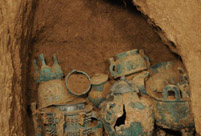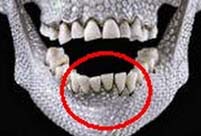 Deng Xiaoping: 'I have a clear conscience all my life'
Deng Xiaoping: 'I have a clear conscience all my life'
 Xi Jinping: 'The people are our strength'
Xi Jinping: 'The people are our strength'
 Amazing cliff diving in cold winter
Amazing cliff diving in cold winter
 Enjoy Sochi 2014 in slow motion
Enjoy Sochi 2014 in slow motion
 University student sentenced to death for poisoning roommate
University student sentenced to death for poisoning roommate
 Chinese lunar New Year celebrated in San Francisco
Chinese lunar New Year celebrated in San Francisco
 Taiwan Lantern Festival 2014
Taiwan Lantern Festival 2014
 Haiyang Yangge: make up
Haiyang Yangge: make up
 China's top 10 richest cities
China's top 10 richest cities
BEIJING, Feb. 26 -- Walking on his tiptoes, Ping'an strolls through Beijing's Forbidden City, his suspecting eyes glowing in the dark of the palace that once housed emperors and their concubines.
For years, the cat has roamed the empty lanes of the former royal palace after it has closed its doors to visitors, in search of his archenemy: mice.
Before being taken in by Shan Jixiang, curator of the Forbidden City, also called the Palace Museum, the animal lived a brutish life, foraging food from dustbins and howling during the night.
According to Ma Guoqing, director of the sanitation department of the Palace Museum, some 200 cats, including Ping'an, whose name can be literally translated to "safety" in Chinese, have in recent years found a home in the Forbidden City.
"Some of them may even be the descendants of royal pets of the past, while the rest are stray cats taken in by the museum staff," said Ma.
As a result, a policy originally aimed at bringing down the population growth of stray cats in the Forbidden City has also generated unexpected results by scaring away rats from the cultural relics.
Cats have long lived in the Forbidden City, which dates back more than 600 years. They were kept as royal pets in the past, playing with the emperor and his relatives.
Now the little creatures have outlived their masters.
Though there are no official records on the current number of stray cats in Beijing, a Capital Animal Welfare Association (CAWA) report in 2010 put the number at around 200,000.
According to the report, one female cat can have as many as three or four litters a year, ultimately adding another 100 cats to the stray population in its lifetime.
Stray cats have always been a headache for China's city authorities, who often receive complaints from residents about the animals' unpleasant smell and night howling.
For the archaeological conservators of the Forbidden City, the rapid surge in the number of cats has also brought a challenge in how to treat the kitties humanely while maintaining a clean and favorable environment.
Ma Guoqing told Xinhua the museum started to realize the seriousness of the problem in 2009, when stray cats in large numbers were often seen skulking through the yard and on the walls.
"The presence of cats could pose a threat to visitors, and their excrement is definitely an eyesore," said Ma.
A special program began in 2009 to take care of the cats.

 Chinese Dream: the Chinese Spirit and the Chinese Way
Chinese Dream: the Chinese Spirit and the Chinese Way 51 bronze sacrificial utensils unearthed in Shaanxi
51 bronze sacrificial utensils unearthed in Shaanxi Most gorgeous female celebs in Chi-pao
Most gorgeous female celebs in Chi-pao Second round of test kicks off at Beijing Film Academy
Second round of test kicks off at Beijing Film Academy Ancient Qiang people had vertically grown teeth
Ancient Qiang people had vertically grown teeth Top 10 Chinese youth’s favorite seaside destinations
Top 10 Chinese youth’s favorite seaside destinations Traditional Tibetan clothing tailors
Traditional Tibetan clothing tailors In photos: Unveiling Taishan station
In photos: Unveiling Taishan station Beautiful moments of family reunion
Beautiful moments of family reunion Chinese warplanes C919 to appear at Singapore Airshow
Chinese warplanes C919 to appear at Singapore Airshow Ruins of Shang Dynasty's structure unearthed in Shaanxi
Ruins of Shang Dynasty's structure unearthed in Shaanxi  Intercity high speed train in operation
Intercity high speed train in operation Severe coldness freezes large parts of China
Severe coldness freezes large parts of China  Beautiful moments of Sochi
Beautiful moments of Sochi  It's not just performing this year
It's not just performing this yearDay|Week|Month